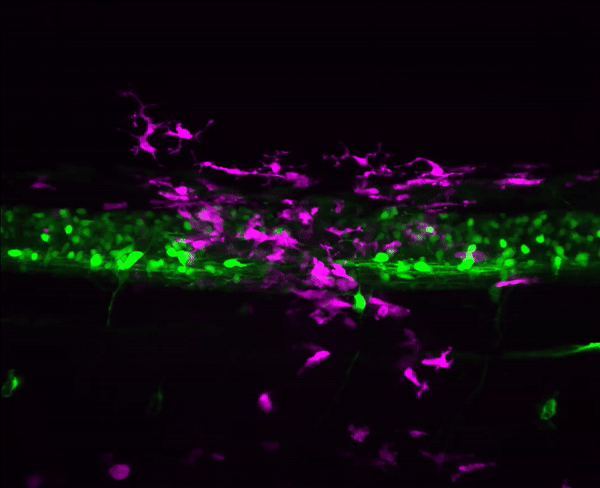Research Focus
During development and regeneration, cell division, differentiation, and death all occur simultaneously within similar and divergent populations. These cell fates must be balanced and coordinated to successfully generate and pattern new tissue. How does the organism determine which cells ‘win’ and which cells ‘lose’ in these processes?
Our research efforts center on the clonal dynamics of stem/progenitor cells and the interactions they have with the immune system during development and regeneration. We aim to understand the mechanisms by which specific cells are eliminated and others are supported by immune cells, with the goal of exploiting unique molecular mechanisms to target specific cells for removal or expansion. We use the zebrafish (Danio rerio) as our primary model organism. Zebrafish are highly regenerative and are able to efficiently repair damage to their heart, brain, spinal cord, and more. They also offer a unique and powerful experimental toolkit and are amenable to high-throughput chemical and genetic screens, sophisticated embryological manipulation, genetic perturbation, and high-resolution imaging. Zebrafish embryos develop and regenerate rapidly and are optically transparent, which allows for unparalleled live observation of cell-cell interactions across multiple stages of development and injury repair. These advantages allow us to investigate fundamental biological questions in ways that would not be possible in other systems.
Current Projects
Neuro-immune interactions in regeneration
The goal of this project is to dissect the molecular patterns associated with immune cells recruited to the regenerating nervous system. Macrophages are recruited to sites of spinal cord injury, physically interact with activated progenitor cells and growing axons, and are essential for successful regeneration. By tracking cell-cell interactions and altering specific pathways, we aim to investigate the influence of the immune system on the growth and fate determinations of individual cells in regeneration.
Species-specific barriers to regeneration
Why do some animals regenerate after injury and others do not? The aim of this project is to identify cellular and molecular mechanisms which confer regenerative and scarring responses to injury across different species. By comparing the immune and progenitor cell behaviors after wounding in regenerative species (Zebrafish) and closely related scarring species (Medaka), we hope to identify and remove barriers to more successful wound healing.

